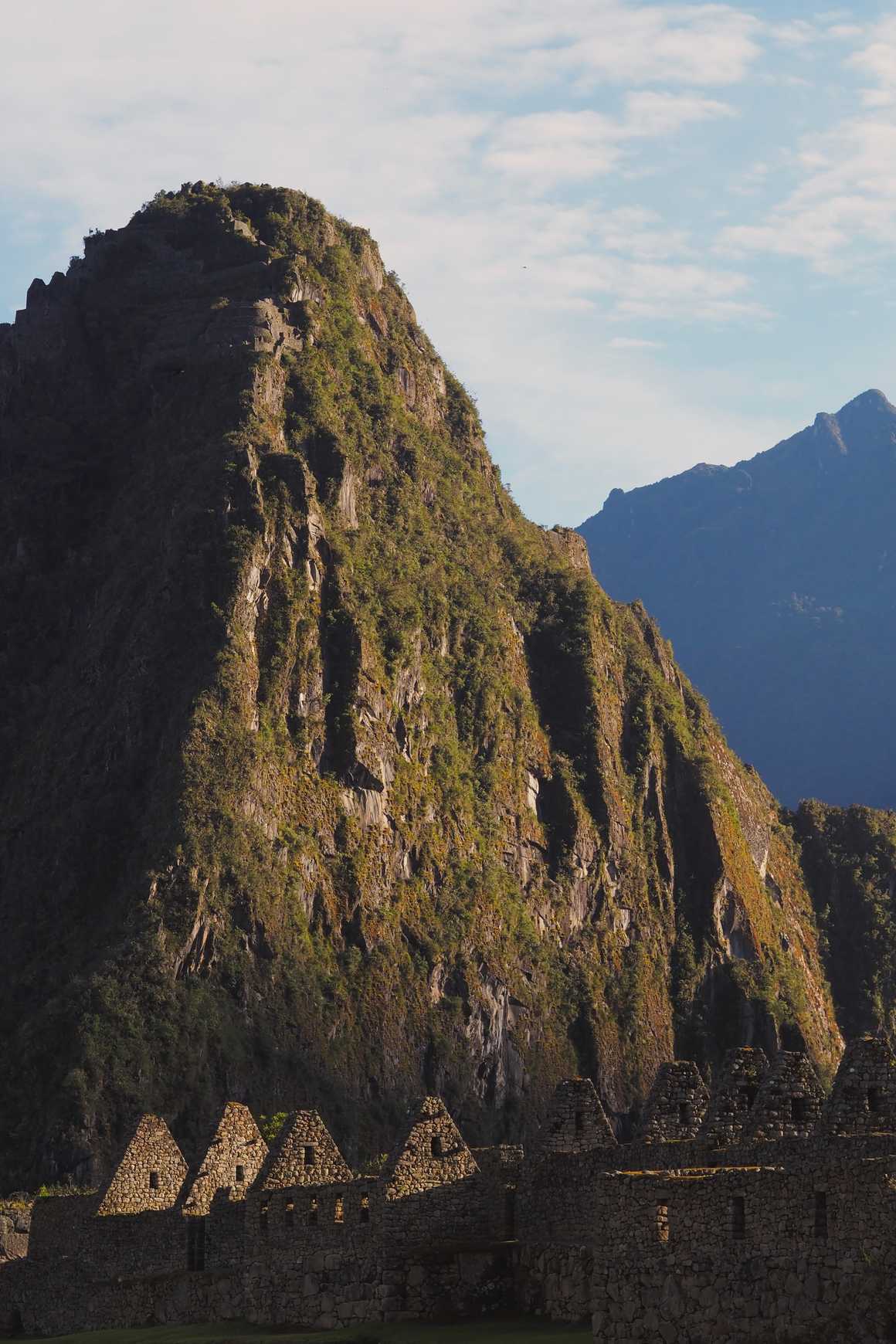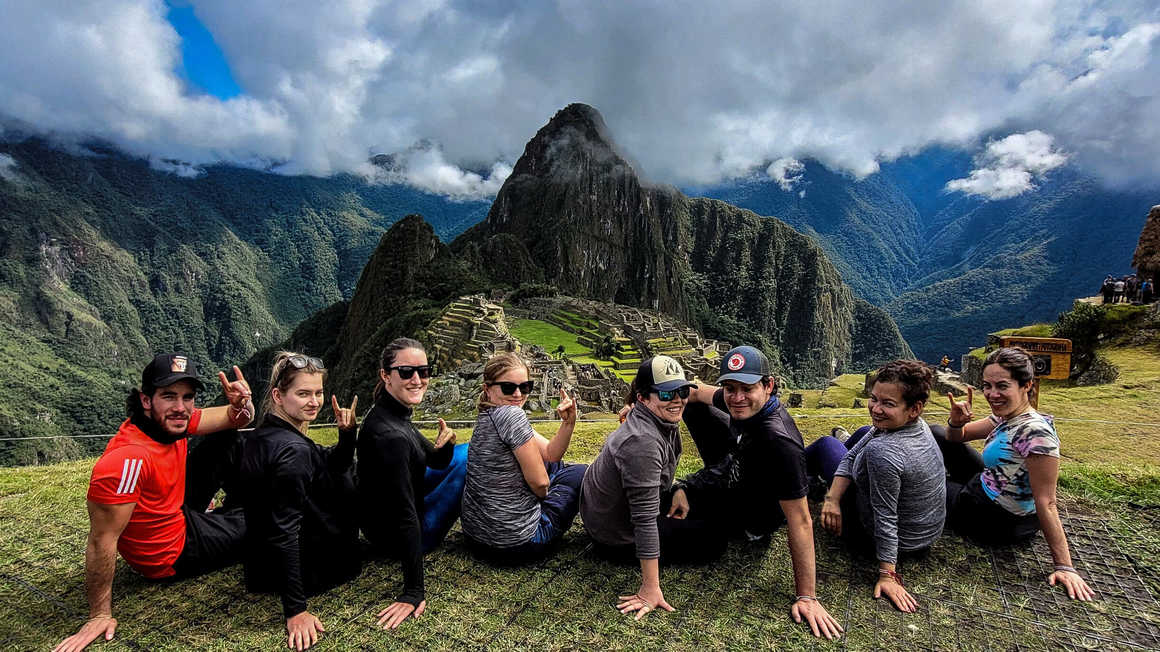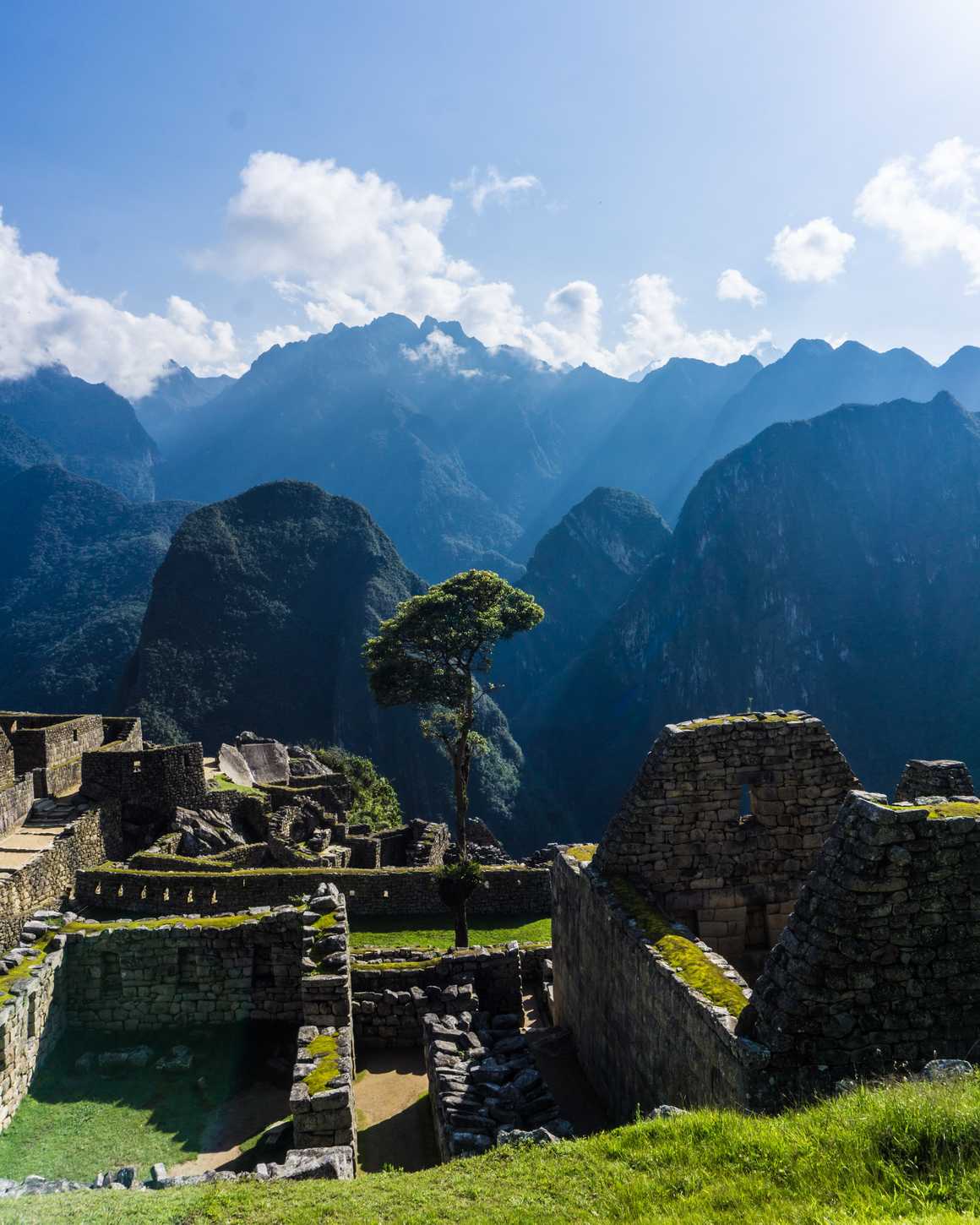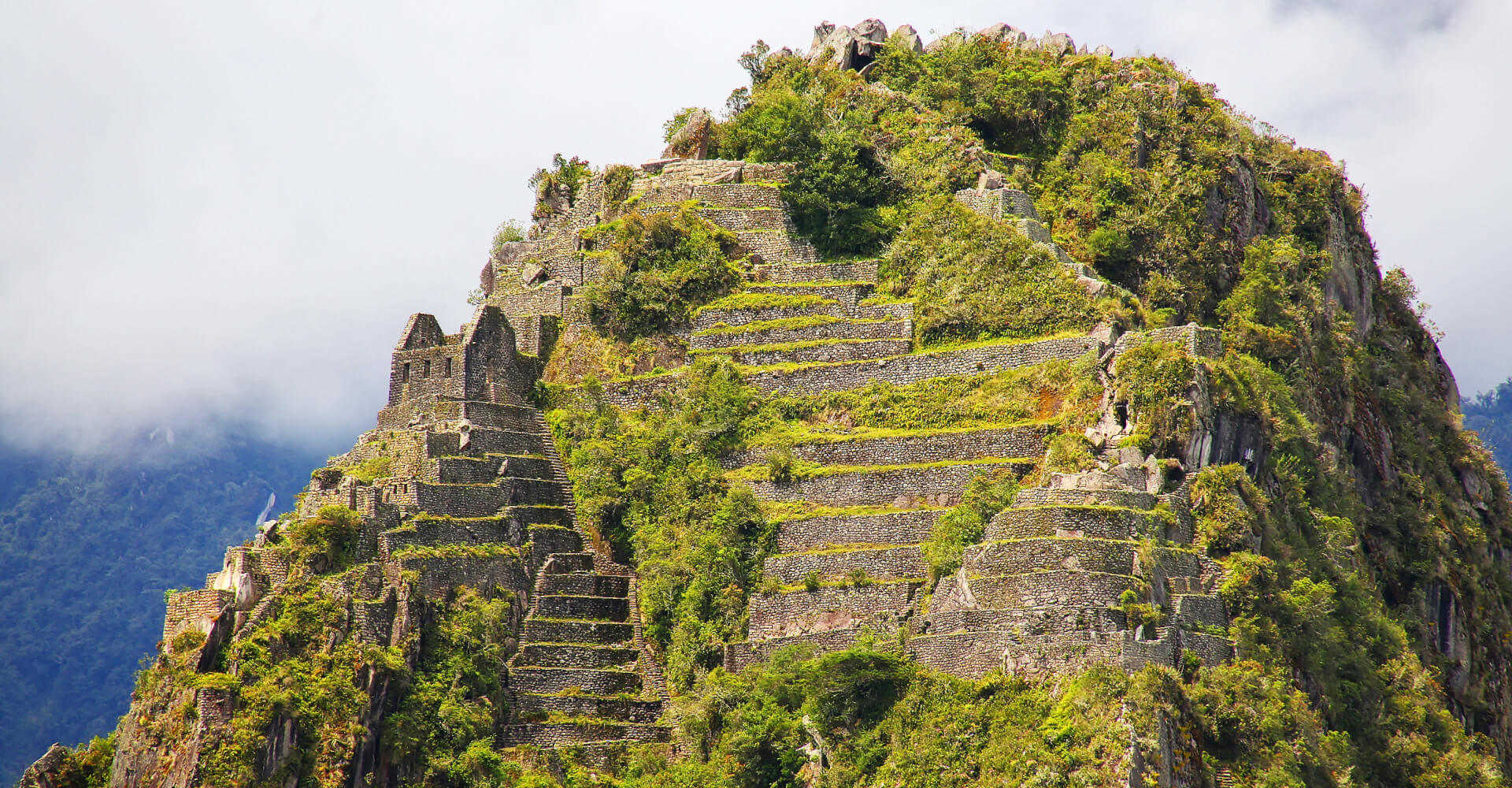Directly behind the Inca site of Machu Picchu stands the towering mountain of Huayna Picchu (aka Wayna Picchu or Wayna Pikchu), meaning 'Young Peak' in Quechua.
Seen in the picture above and made famous by the iconic images of Machu Picchu plastered over coffee shops and hotels across the world, climbing Huayna Picchu is a favourite of many trekkers who visit the ancient site. Looming over the city, Huayna Picchu offers incredible bird eye views of the citadel and its surrounding areas that should not be missed.
Although the pictures of Huayna Picchu suggest a steep, technical cliff face style climb, this is not the case. Climbing Huayna Picchu requires no technical skills and is simply a steep hike that occasionally will require the use of both your hands and feet.
Caution should be taken throughout the climb as there are areas exposed to steep drops and this is more true in wet conditions in which a good distance should be kept between you and other climbers on the path. Many of the steep sections have rails and cables to hold on to if you feel your footing starting to go. If you are fit enough to hike the Inca Trail then you should be fine climbing Huayna Picchu as it is not a hugely difficult hike. However, if you are susceptible to vertigo or suffer from heights then we would suggest sitting this one out.
The total ascent is just over a 1000 feet (360 meters) and the summit allows views of the ancient city that cannot be fully appreciated from the ground. The complexity of the city come to life from above allowing you to fully comprehend the magnitude of the site and the ingenious way in which it was built. The summit also bears remnants of terraces and temples that will leave you totally confounded as to how they were built.

Climbing Huayna Picchu - Rules and Permits
Back in the day climbing Huayna Picchu was easy, no permits were needed and any amount of trekkers could climb it. This is not the case today.
Unregulated climbing led to the inevitable degradation of the site and often disrupted ongoing archaeological work that is still carried out today. This, along with the safety risk of steep crowded paths led to the current situation implemented by the National Institute of Culture of Peru (INC) to regulate climbing on Huayna Picchu.
Initially a permit system was put in place that allowed only 400 climbers per day onto Huayna Picchu with no regulated hiking times. Climbers could ascend and descend in their own time as long as they ascended at least 2 hours before closing time. However, in the summer of 2011, this ruling changed and climbing times were implemented.
The new rules allow two group departure times with 200 permits for each group. For the early birds out there, the first tour group ascend from 7-8am while the second group ascend between 10-11am. The climb takes roughly an hour to ascend and 45 minutes to descend. Both times offer incredible views and whilst the earlier tour will get the stunning early morning light, it is often misty - something the second tour usually avoids. Officially, the first tour should be off the mountain by the time the second tour begins to avoid a crowded cross over, however, this is rarely the case as many early trekkers will ascend gradually and wait at the summit for the mist to clear.
Children under the age of 12 are not permitted to climb Huayna Picchu.

Climbing Huayna Picchu - The 7am or 10am Tour?
Like everything, there are pros and cons to both tour times. The earlier tour avoids the heat of the day which, in the hotter months, can be quite extreme. That being said, the 2nd tour will often avoid the early morning mist and fog that can sometimes plague the first tour and obscure the views. If the mist and fog are not present then the early morning light coupled with the incredible view makes for an unbeatable sight!
Avoiding crowds is a key factor in your enjoyment of Machu Picchu. Visitors arriving by train will roll in around 11am by which time the first tour has descended and is likely to meet the hordes of crowds head on. With that being said, climbing Huayna Picchu is a quieter affair on the earlier tour as you don't meet anyone else coming down. Trekkers on the second tour are likely to encounter more people at the summit as many hikers from the first tour will still be there.
If we had to come down on one side or the other we would probably suggest the second tour as it gives you time to enjoy the citadel before the onslaught of tourists from Cusco. Moreover, although you will have to contend with a busier mountain, there is a far greater chance of clear views (which is the main reason for climbing Huayna Picchu) and many of the daily tourists have left for lunch by the time you descend.
Remember, this is all null and void if you do not book early enough!
If permits have run out when you come to book Huayna Picchu then don't panic, there are other alternatives that also offer great views of the ancient citadel.
Climbing Huayna Picchu - Other Alternatives
If it's a birds eye view of Machu Picchu that you want then there are three other alternatives to Huayna Picchu - Putukusi Mountain, The Sun Gate and Cerro Machu Picchu (also know as Machu Picchu Mountain or Monta?a).
Putukusi Mountain (3,560M Above Sea Level)
If your one of the lucky ones spending two days within the Machu Picchu sanctuary and like adventure then maybe the Putukusi Mountain (happy mountain) trek from Aguas Calientes is for you. Unlike climbing Huayna Picchu, this trek is not for the faint-hearted and is far more challenging.
To access the climb you need to follow the railway tracks from Aguas Calientes towards Machu Picchu. Along the track on the right hand side you will see a sign for Putukusi Mountain. Over stone steps and ladders, the track ascends steeply for 600m with the largest ladder being 60m and should be ascended with caution as a fall from those heights could be fatal. The final ascent to the summit winds and zigzags along a steep hill.
Total ascent time is around 1.5-2 hours with a very similar time to descend. The views from the top are spectacular and the route is quite often deserted.
No permit is required for this trek, however, we would recommend only very fit individuals who have no problems with vertigo or height. The ladder sections can be quite alarming even for experienced trekkers.

The Sun Gate (Inti Punku)
Most people who trek the Inca Trail will know the Sun Gate as it is the first site you reach when approaching Machu Picchu and provide stunning views over Machu Picchu.
For trekkers entering Machu Picchu from various other routes you need to backtrack through the classic Inca Trail past the Caretakers Hut to Inti Punku which is all well sign-posted. The trek takes roughly 30 minutes each way and is a fairly gradual hike on the way out.
Many day trekkers to the site will make sure they are there nice and early on the first bus so they can reach the Sun Gate in time to witness the sun rise over the city.
Cerro Machu Picchu (3,051m Above Sea Level)
Sitting directly across from Huayna Picchu is Cerro Machu Picchu, the largest mountain in the site's complex. Although nearly twice the height of Huayna Picchu, the 1,850 foot ascent up Cerro is far more gradual than that of Huayna Picchu.
The views from the top are simply breathtaking, arguably better than Huayna Picchu, as the views of Machu Picchu are slightly more gradual allowing the ruins to be more exposed. The trail is also far more quite than that of Huayna so crowds are not a factor.
For an average trekker it will take roughly 2-2.5 hours to summit the mountain from the ruins and roughly 1 hour to descend back down. We would suggest hiking up Cerro late morning as you can complete your guided tour of the city and still arrive back in time before the site closes for the day. Ideally, if you are one of the lucky ones staying two days, then this hike should be done on the second day.
Unlike Huayna Picchu, Cerro is a great option for children as the trail is very gradual and far more family friendly.
To reach the mountain, head towards the Sun Gate back along the Inca Trail until you reach the caretakers hut, there you will see a sign directing you towards Machu Picchu Mountain.
Like Huayna Picchu, a permit is required for Cerro Machu Picchu. This costs 140PEN (~US$45) and, once again, includes admission into Machu Picchu. Permits can be bought through us or on the Peru Ministry of Culture website. Please Note the mountain is marked as Machu Picchu + Montana on their website. For more information please contact a Kandoo specialist.










